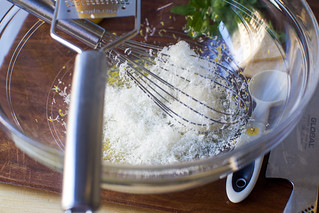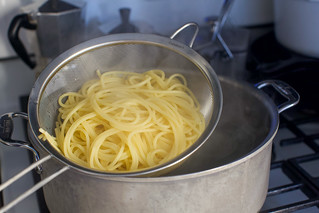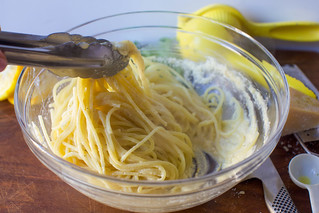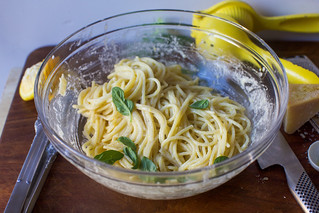In 2011, I shared a recipe for spaghetti with cheese and black pepper (cacio e pepe) but it always bothered me that it contained extra ingredients and that the technique left a wide margin of error. In 2018, I finally cracked the code at home and ran to the internet to tell you about it. Today I’m sharing what I hope will be a similar glow-up for spaghetti (or fettuccine) al limone, a classic pasta dish from, depending on who you are asking, Genoa, Amalfi, Sicily and further (the common thread is, no surprise, places where lemons are grown). In its simplest form, spaghetti al limone contains only lemons, olive oil, parmesan, salt, pepper, and a few leaves of fresh basil in an uncooked sauce. Versions abound, including mine from 2011, with cream, butter, wine, shallots, or more, usually simmered and reduced. Garlic, ricotta, and/or goat cheese are not uncommon. I suspect it’s less due to a blasphemous streak or attempting to bait this parody account, but because they are all delicious. You should feel no obligation to choose.

But it was the River Cafe London’s 30th anniversary cookbook edition, released last year, that reminded me of what a pure and wonderful thing spaghetti al limone can be when made as uncluttered as possible. Their minimalist version is heated at the end but I found the technique I use for my foolproof cacio e pepe — a thicker paste of a sauce, thinned with just a small splash of pasta water after it has coated the hot spaghetti — to work more reliably, and to all but eliminate leading weary home cooks to wonder why they haven’t been able to coalesce oil and water together on a Tuesday night. I find I need much less lemon and olive oil, as well. Marcella Hazan calls fettuccine al limone “one of those lightning-quick Italian triumphs” and she, SK’s patron saint of Italian triumphs, seems like a good person to trust on this. It takes all of a minute longer to make than pasta takes to boil and the result is the kind of sunny, summery, quick meals we all need more of in our repertoires.






Previously
One year ago: Linguine and Clams
Two years ago: Stovetop Americanos
Three years ago: Strawberry Milk and Corn and Black Bean Weeknight Nachos
Four years ago: Strawberry Cornmeal Griddle Cakes and Strawberry Cheesecake Ice Cream Pie
Five years ago: Valerie’s French Chocolate Cake
Six years ago: Espresso Granita with Whipped Cream
Seven years ago: Broccoli Parmesan Fritters
Eight years ago: Dobos Torte
Nine years ago: Mushroom Crepe Cake, Braided Lemon Bread and Carrot Salad with Harissa, Feta and Mint
Ten years ago: Lemon Mint Granita, Pickled Sugar Snap Peas and Springy Fluffy Marshmallows
Eleven years ago: 10 Paths to Painless Pizza-Making and Pistachio Petit-Four Cake
Twelve years ago: Gateau de Crepes and Dilled Potato and Pickled Cucumber Salad
And for the other side of the world:
Six Months Ago: Crispy Rice and Egg Bowl with Ginger-Scallion Vinaigrette
1.5 Years Ago: Boulevardier and Sheet Pan Meatballs with Crispy Turmeric Chickpeas
2.5 Years Ago: Pimento Cheese Potato Bites
3.5 Years Ago: Tres Leches Cake + A Taco Party and Eggnog Waffles
4.5 Years Ago: Jelly Doughnuts and Endives with Oranges and Almonds
Simplest Spaghetti al Limone
If you can find an unsprayed/unwaxed lemon, it’s all the better here. If you can’t, give your lemon a light scrub (not removing zest, of course) and dry it thoroughly before zesting it here.
- Coarse salt
- 1/2 pound (8 ounces or 225 grams) dried spaghetti
- 1 lemon
- 3 1/2 ounces (100 grams) parmesan cheese
- Freshly ground black pepper
- 3 tablespoons (45 ml) olive oil
- Fresh basil leaves, torn
Source: http://feedproxy.google.com/~r/smittenkitchen/~3/ePJGVEGHT3o/